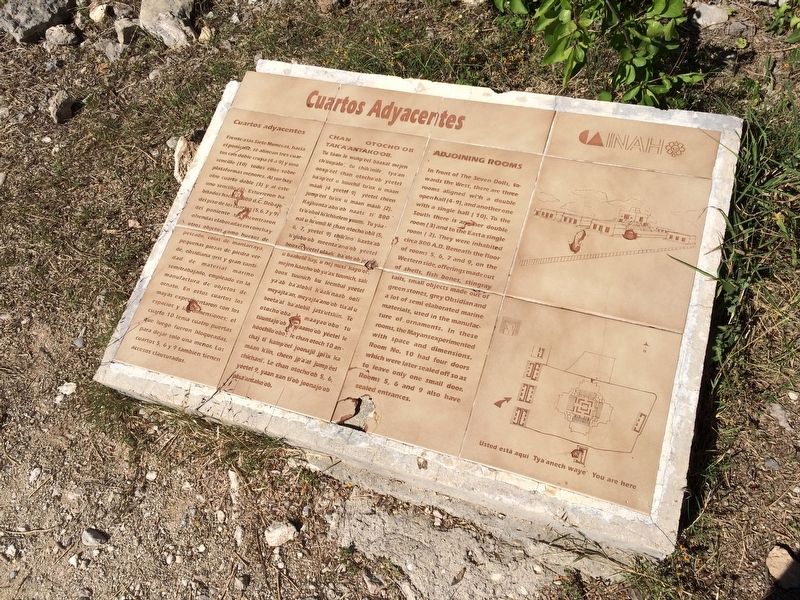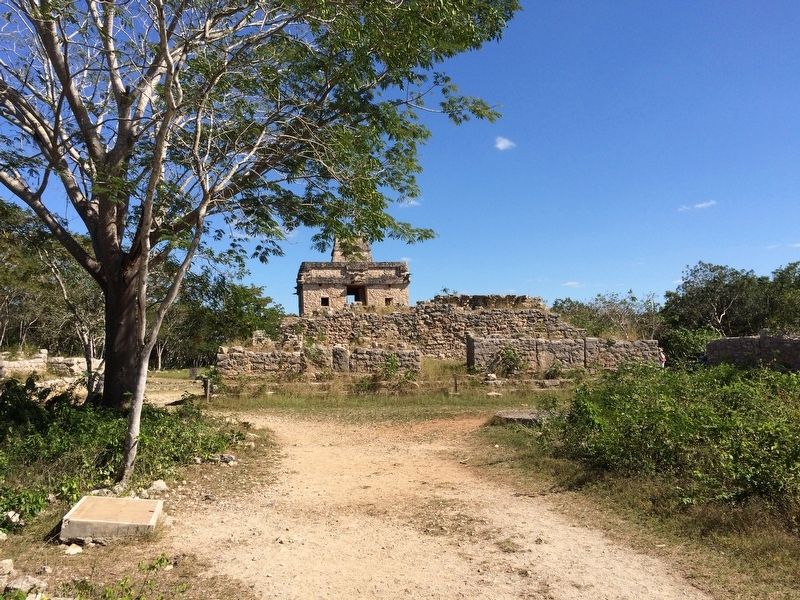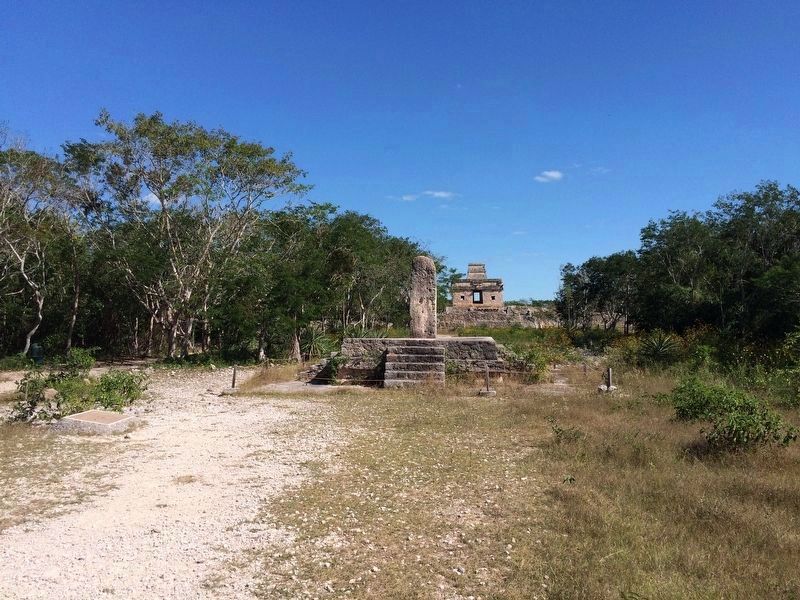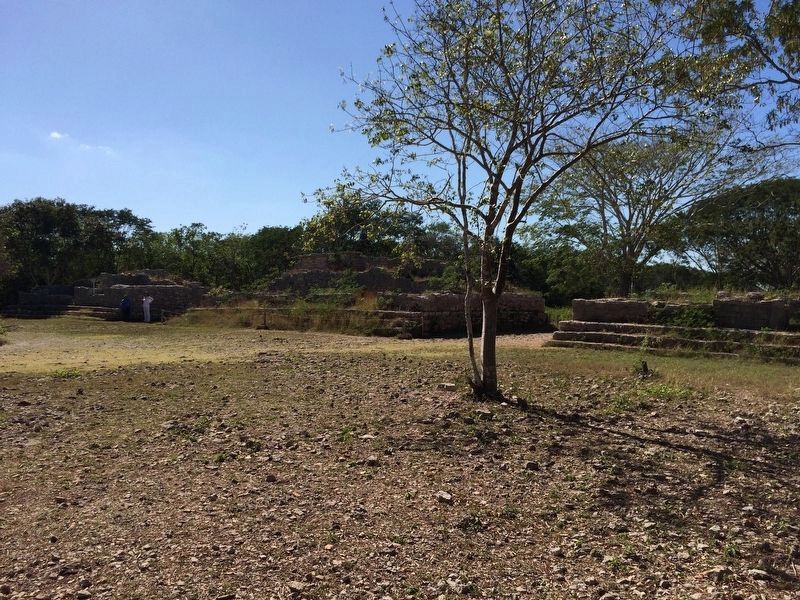Dzibilchaltún in Mérida, Yucatán, Mexico — The Southeast (Yucatan Peninsula)
Adjoining Rooms
Cuartos adyacentes
Frente a las Siete Muñecas, hacia el poniente, se alinean tres cuartos con doble crujía (4 a 9) y uno sencillo (10) todos ellos sobre plataformas menores. Al sur hay otro cuarto doble (3) y al este uno sencillo (2). Estuvieron habitados hacia 800 d.C. Debajo del piso de los cuartos (5, 6, 7 y 9) del poniente se encontraron ofrendas elaboradas en concha y otras objetos como huesos de pescado, colas de mantarraya, pequeñas piezas de piedra verde, obsidiana gris y gran grantidad de material marino semitrabajado, empleado en la manufactura de objetos de ornato. En estos cuartos los maya experimentaron con los espacios y las dimensiones; el cuarto 10 tenia cuatro puertas que luego fueron bloqueadas, para dejar solo una menor. Los cuartos 5, 6 y 9 también tienen accesos clausurados.
Maya-Yucateco:
Chan Otocho’ob Tak’a’antako’ob.
Tu táan le wukp’éel báaxal mejen ch’úupalo’, tu chi’inile, tya’an óoxp’éel chan otocho’ob yéetel ka’ap’éel u kúuchil tu’ux u máan máak (4 yéetel 9) yéetel chéen jump’éel tu’ux u máan máak (2). Kajkunta’abo’ob naats’ ti’ 800 ts’o’okol ki’ichkelem yuum. Tu yáanal u lu’umil le chan otocho’obil (5, 6, 7, yéetel 9) chik’ino’ kaxta’ab k’úubo’ob meenta’ano’ob yéetel booxel yéetel uláak ba’alo’ob je’ u baakelil kay, u nej nuxi’ kayo’ob, mejen káacho’ob ya’ax tuunich, sak book tuunich ku léembal yéetel ya’ab ba’alobil k’áak’náab óoli’ meyajta’an, meyajta’ano’ob tia’al u beeta’al ba’alobil jats’utskin. Te´otocho’oba’ le maaya’obo’ tu túuntajo’ob yaamo’ob yéetel le kóochilo’obo’; le chan otoch 10 anchaj ti’ kamp’éel joonajil jpi’ix ka máan k’iin, chéen jp’a’at jump’éel chichani’. Le chan otocho’ob 5, 6, yéetel 9, yaan xan ti’ob joonajo’ob pixa’antako’ob.
English:
Adjoining Rooms
In front of The Seven Dolls, towards the West, there are three rooms aligned with a double open hall (4-9), and another one with a single hall (10). To the South there is another double room (3) and to the East a single room (2). They were inhabited circa 800 A.D. Beneath the floor of rooms 5, 6, 7 and 9, on the Western side, offerings made out of shells, fish bones, stingray tails, small objects made out of green stones, grey Obsidian and a lot of semi elaborated marine materials, used in the manufacture of ornaments. In these rooms, they Mayans experimented with space and dimensions. Room No. 10 had four doors which were later sealed off so as to leave only one small door. Rooms 5, 6 and 9 also have sealed entrances.
Erected by Instituto Nacional de Antropología e Historia (INAH).
Topics. This historical marker is listed in these topic lists: Anthropology & Archaeology
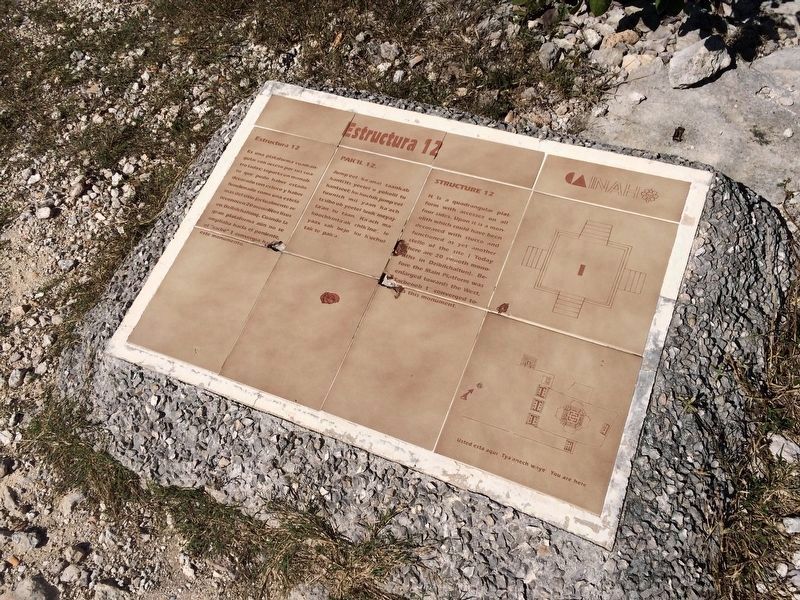
Photographed By J. Makali Bruton, January 11, 2017
2. Additional nearby Structure 12 marker
This nearby marker is further to the west past Structure 12 from the Adjoining Rooms marker. It reads:
Estructura 12
Es una plataforma cuadrangular on acceso por sus cuatro lados; soporta un monolito que pudo haber estado decorado con estuco y haber funcionado como una estela más del sitio (actualmente se reconocen 20 monolitos lisos en Dzibilchaltún). Cuando la gran plataforma aún no se ampliaba hacia el poniente, el “sacbé” 1 convergia hacia este monumento.
Maya-Yucateco:
Pak’il 12.
Jump’éel ka’anal táankab kanti’its yéetel u yokolil tu kantséel; ku kuchik jump’éel tuunich mii yaan ka’ach ts’iibo’ob yéetel luuk’ meyajta’an tu táan. Ka’ach ma’kóochkinta’ak chik’ine’, le yáax sak bejo’ ku k’uchul tak te’ pak’a’.
English:
Structure 12
It is a quadrangular platform with accesses on all four sides. Upon it is a monolith which could have been decorated with stucco and functioned as yet another stele of the site (Today there are 20 smooth monoliths in Dzibilchaltún). Before the Main Platform was enlarged towards the West, “Sacbeoob 1” converged towards this monument.
Estructura 12
Es una plataforma cuadrangular on acceso por sus cuatro lados; soporta un monolito que pudo haber estado decorado con estuco y haber funcionado como una estela más del sitio (actualmente se reconocen 20 monolitos lisos en Dzibilchaltún). Cuando la gran plataforma aún no se ampliaba hacia el poniente, el “sacbé” 1 convergia hacia este monumento.
Maya-Yucateco:
Pak’il 12.
Jump’éel ka’anal táankab kanti’its yéetel u yokolil tu kantséel; ku kuchik jump’éel tuunich mii yaan ka’ach ts’iibo’ob yéetel luuk’ meyajta’an tu táan. Ka’ach ma’kóochkinta’ak chik’ine’, le yáax sak bejo’ ku k’uchul tak te’ pak’a’.
English:
Structure 12
It is a quadrangular platform with accesses on all four sides. Upon it is a monolith which could have been decorated with stucco and functioned as yet another stele of the site (Today there are 20 smooth monoliths in Dzibilchaltún). Before the Main Platform was enlarged towards the West, “Sacbeoob 1” converged towards this monument.
Location. 21° 5.469′ N, 89° 35.463′ W. Marker is in Dzibilchaltún, Yucatán, in Mérida. The marker is located about 150 meters to the left after the entrance to the Dzibilchaltun Archaeological Zone, along the "sacbe" towards the Seven Dolls Temple. The park is off the road towards the small village of Dzilbilchaltun, to the east some 20 km north of Mérida on the Mérida-Progeso Highway (Hwy. 261). Touch for map. Marker is in this post office area: Dzibilchaltún YU 97300, Mexico. Touch for directions.
Other nearby markers. At least 8 other markers are within walking distance of this marker. The Seven Dolls (within shouting distance of this marker); The Habitational Complex (about 210 meters away, measured in a direct line); Sacbe 1 (approx. 0.4 kilometers away); Dzibilchaltún Archaeological Site (approx. 0.6 kilometers away); Structure 36 (approx. 0.6 kilometers away); The Open Chapel (approx. 0.6 kilometers away); Central Square (approx. 0.6 kilometers away); Substructure 38 (approx. 0.7 kilometers away). Touch for a list and map of all markers in Dzibilchaltún.
Credits. This page was last revised on October 14, 2022. It was originally submitted on January 31, 2017, by J. Makali Bruton of Accra, Ghana. This page has been viewed 210 times since then and 6 times this year. Photos: 1, 2, 3, 4, 5. submitted on January 31, 2017, by J. Makali Bruton of Accra, Ghana.
